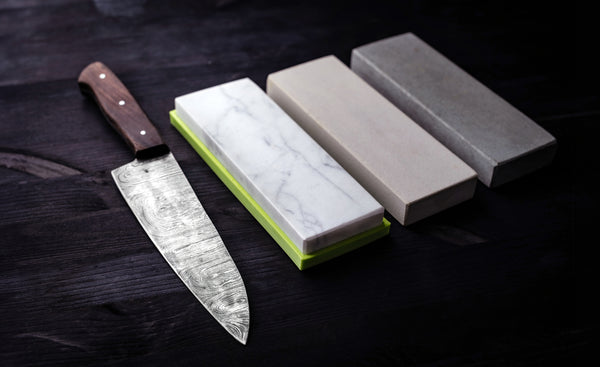What Is A Whetstone? – An Introduction To Japanese Sharpening Tools

Jump to:
The fact that whetstones are wet and that they have a similarity to water stones often leads to them being referred to as “wet stones”. However, the “whet” in “whetstone” actually has nothing to do with their dampness, but rather means “to sharpen.” Japan is famous for its ultra-sharp swords, and more relevantly in the modern age, knives, so it is no surprise that it has developed excellent ways of keeping them sharp over the centuries. In this blog post, we will first define differences in terms such as sharpening stones, whetstones, and water stones so that we know what we are talking about, and then discuss the history of whetstone use in Japan. Following that, we shall describe the way to sharpen a knife using a whetstone, look at a number of different whetstones, and analyze which is the best one to use for each purpose.
Hopefully, we have “whet your appetite” (all puns intended) to look into this topic more deeply, so let’s begin!
Is It A Sharpening Stone, A Whetstone, Or A Water Stone?

Beginners to this subject may be confused by terms such as sharpening stone, whetstone, and water stone, as the difference between them is not clear at first glance. I will start by giving the rule before homing in on the nuance.
Basically, all sharpening stones are whetstones, as they mean the same thing (as previously mentioned, “whet” means to sharpen). Water stones are a subset of sharpening stones/whetstones (in fact, a very large subset among Japanese whetstones).
Sharpening stone is a collective term that covers any stone used to sharpen a variety of tools, such as chisels, axes, sickles, and, of course, knives and swords. Such stones include ceramic sharpening stones, diamond sharpening stones, and Japanese water stones.
Japanese water stones are made from a wide variety of materials combined with water. The idea is that the speed and ease of sharpening are increased by the “slurry” created when the water mixes with the loose sharpening particles of the material. Combining it with water also means that the material removed by the sharpening process is immediately drained away, preventing the metal particles from attaching themselves to the stone and scratching the blade that you are sharpening.
Natural whetstones use sedimentary rock with water, but not all Japanese whetstones are water-based. There are diamond whetstones and oil-based whetstones, as well. However, the majority use the techniques described above.
History Of Whetstones In Japan
It is said that the whetstone dates back to the Jomon period (approximately 13,000 BCE to 3,000 BCE) due to the natural abundance of tools useful for sharpening stones in Japan. Following this, they were mined and processed for centuries due to their essential role in Japan’s military endeavors (for sword sharpening). This historical importance has meant that Japan has been able to develop excellent blade-sharpening techniques. Whereas the reckless wielding of swords by the average citizen is actively discouraged these days, their importance has passed the test of time, and they are considered essential for in the modern age, not only for maintaining the traditional cultural heritage of Japanese sword-making but also supporting the flourishing Japanese kitchen knife industry.
How Do You Sharpen A Knife Using A Whetstone?

There is nothing very complicated about using a whetstone to sharpen your knife, and as long as you follow the procedure outlined below, success is (virtually) guaranteed. Whetstones will often come with a coarse and a fine side. The coarseness is measured in terms of grit. So, for example, the coarse side may be 1000 grit and the fine side may be 6000 grit.
(1) First submerge your whetstone in water. Bubbles will naturally appear. Wait for the bubbles to slow down or stop before removing the whetstone from the water.
(2) Remove the whetstone and make sure the coarser side is facing up first.
(3) Hold the knife at a 15°angle. You don’t need to measure too precisely, but as a general guide, it works out at approximately half the height of your thumb.
(4) Slide the knife away from you with minimal pressure.
(5) After making about 15 passes, flip the knife over and repeat.
(6) Now turn the whetstone over so that the finer surface (higher grit number) is facing up, and add a little water.
(7) Repeat the process with the same angle and method, but only ten passes or so are required this time around.
Now, all that is left to do is to test the sharpness of your knife. It should be pretty sharp, so we would recommend using a piece of paper or unwanted cloth to do this, rather than your finger.
If you would like a more detailed guide to the sharpening process, you may find this article interesting.
What Whetstone Should You Purchase?
There is a large range of whetstones to choose from depending on your budget and your purpose in using the whetstone. The Daitool website is a great place for you to start your whetstone journey.
As mentioned previously, the coarseness of a whetstone is measured by its grit level. Anything below 1000 is fairly coarse, whereas anything above 5000 is very fine. There are, of course, many that fall between these two extremes as well. The decision on how coarse you want your whetstone to be depends on what you want to use it for. If you are trying to get the optimal sharpness on your blade, you will want to use a very fine whetstone, whereas if you are trying to thin the blade or repair dents, etc. in the blade, you should use a coarser variety.
King Deluxe Whetstone Sharpening Stone 800 Grit
King prides itself on producing affordable whetstones with a high level of quality, so is a great choice for your first whetstone. This 800-grit model is a good example of a relatively inexpensive coarse soft stone whetstone that is ideal for thinning everyday dull, damaged, or chipped blades, such as sickles, chef’s knives, and garden shears.
The King range also comes in a 1000-grit version if you need your blades to be slightly sharper, or the 6000-grit version if you are looking for a really fine whetstone.

King Deluxe Whetstone Sharpening Stone 800 Grit
$29.90
Suehiro Super Fine Finishing Whetstone 8000 Grit W-8
Although slightly more expensive, the Suehiro range is another solid choice of whetstone. If you are looking to make your blades ultra-sharp, you should look no further than this 8000-grit model. It is an artificial whetstone that is highly durable, with an even finish and a surface that is free from impurities, which alleviates any concerns you may have that the whetstone will scratch your blade. As it has a really high level of fineness, it should only be used on blades that are already in good condition or have been sharpened recently.
The Suehiro range also comes with coarser blades, including a 5000-grit model.
Another factor that comes into the equation when deciding on what whetstone to purchase is your choice of material. Ceramic whetstones have a long lifespan, do not wear easily, and require minimal care. They are a good choice for those buying for the long term, as well as buyers who are less experienced when it comes to maintaining their whetstones. If you are interested in a ceramic whetstone, we would recommend you to check out the Shapton range.

Suehiro Super Fine Finishing Whetstone 8000 Grit W-8
$126.00
Shapton Pro Kuromaku Whetstone Ceramic Sharpening Stone 320 Grit K0707
This is one of the coarsest whetstones available. This whetstone is highly recommended if you are looking to thin or repair blades, including the removal of bends or chips on the blade.
If you would like a ceramic whetstone but are looking for something finer, you should also check out the 1500-grit and 2000-grit versions.
This post has mainly centered on whetstones used for sharpening knives, but if you are in the gardening or harvesting business and you have a specific need for a whetstone to sharpen your sickle, we have you covered here too.

Shapton Pro Kuromaku Whetstone Ceramic Sharpening Stone 320 Grit K0707
$42.00
Suehiro Coarse Carbon Whetstone For Sickles 120 Grit 521-C
This dedicated sickle whetstone is 120 grit, made of coarse carbon, is a reasonably inexpensive way of ensuring that your sickle is free of any dents or chips. Once your sickle blade is repaired or thinned adequately, however, and you are looking to improve the sharpness of your sickle, then you can use this 1000-grit in the same range.

Suehiro Coarse Carbon Whetstone For Sickles 120 Grit 521-C
$34.00
The Whetstone – The Simple And Efficient Sharpening Tool
It is perhaps not surprising that Japan, with its long history of sword usage, and blessed with a rich natural supply of rocks that can be used as sharpening tools, has developed a simple, yet efficient way of maintaining the sharpness of blades. The whetstone is the embodiment of the Japanese cultural maxim that “simple is best” and once you try using them, you will be amazed at how easy it is to keep your kitchen knives and other tools at their required sharpness.
Have you tried using a Japanese whetstone? Let us know your impressions when using it in the comments.

0 comments